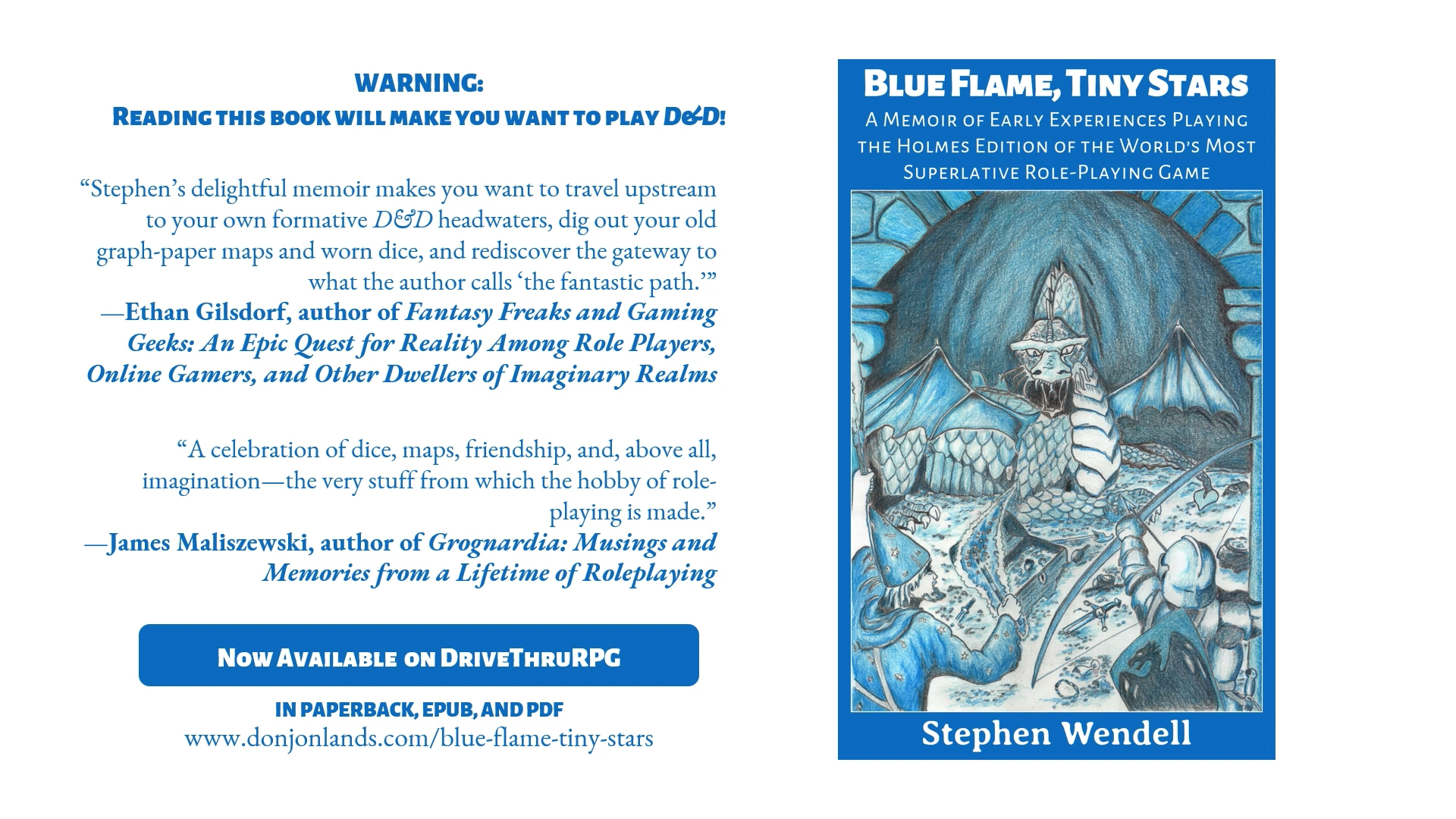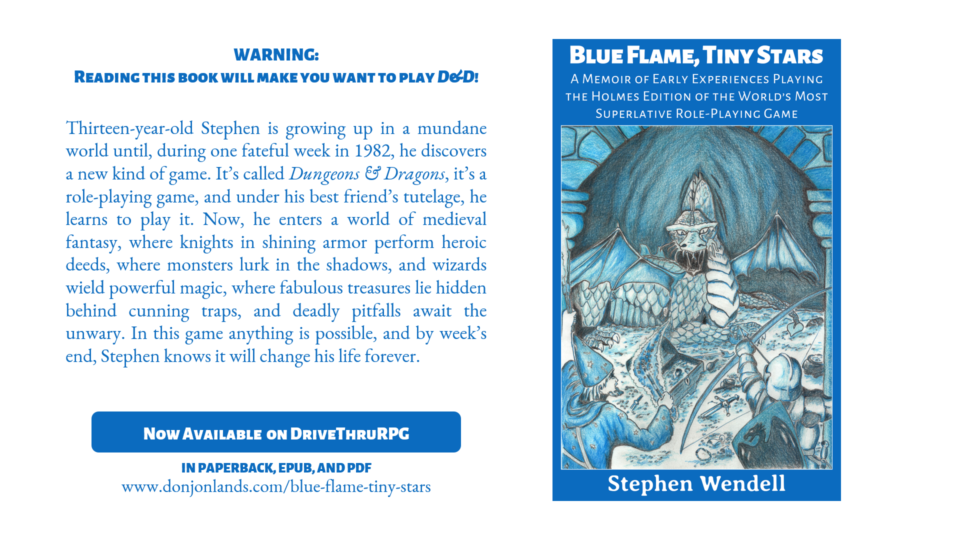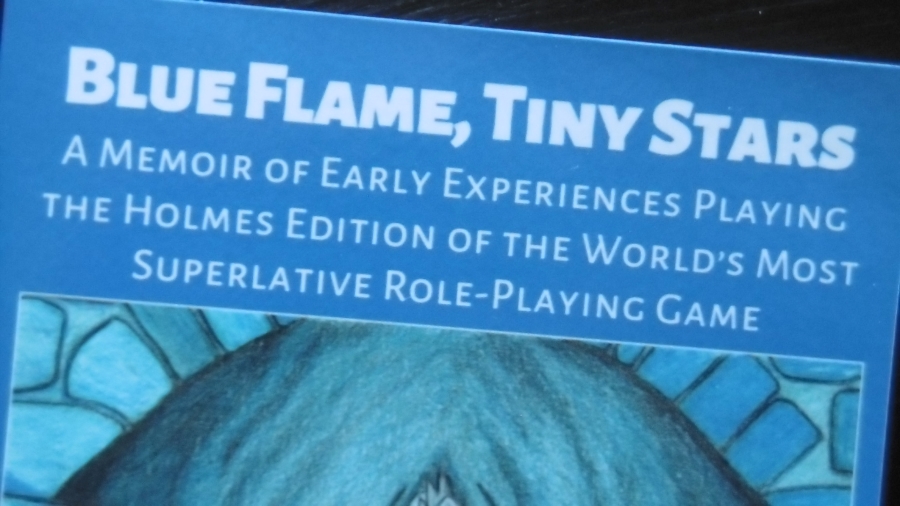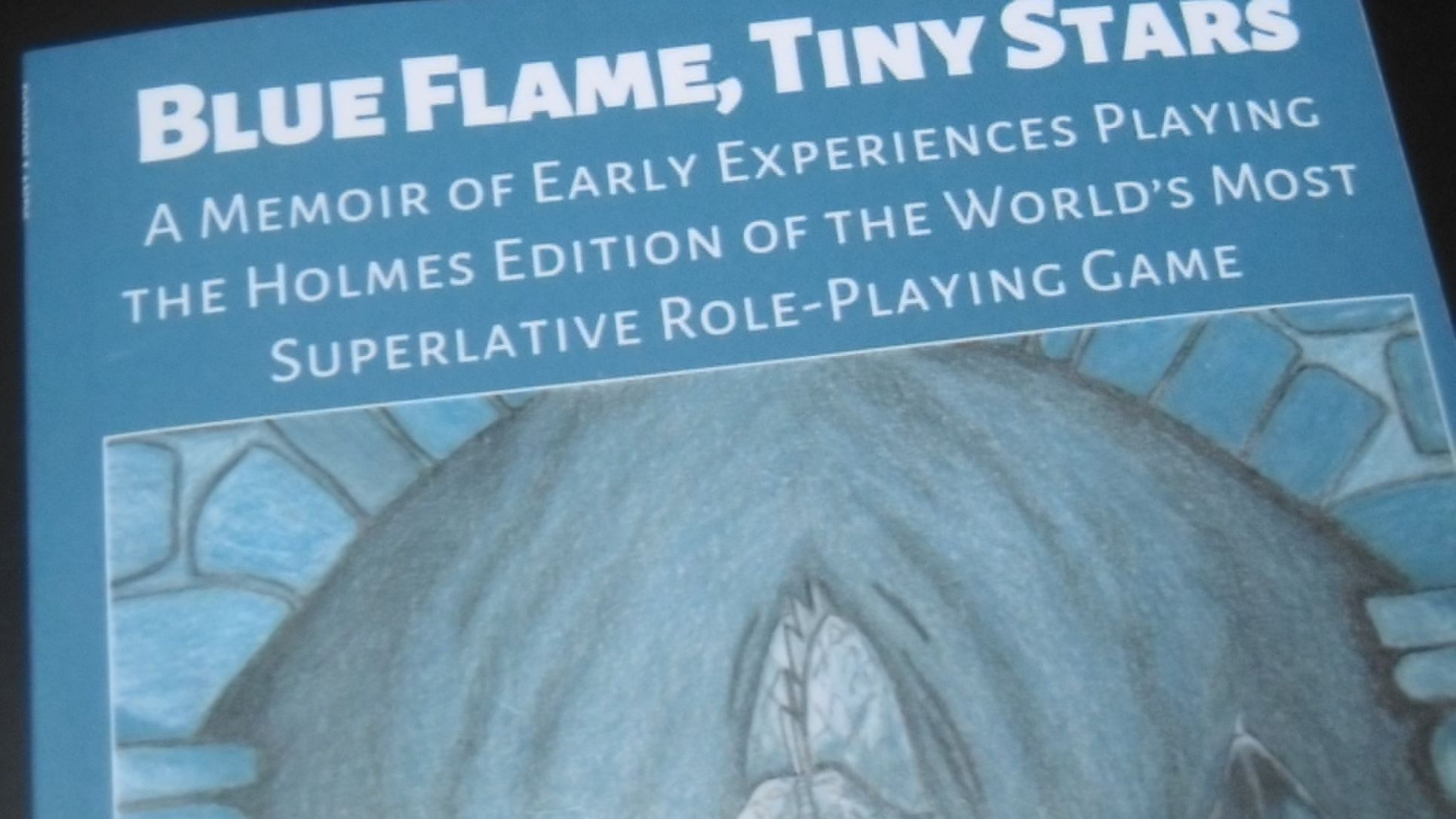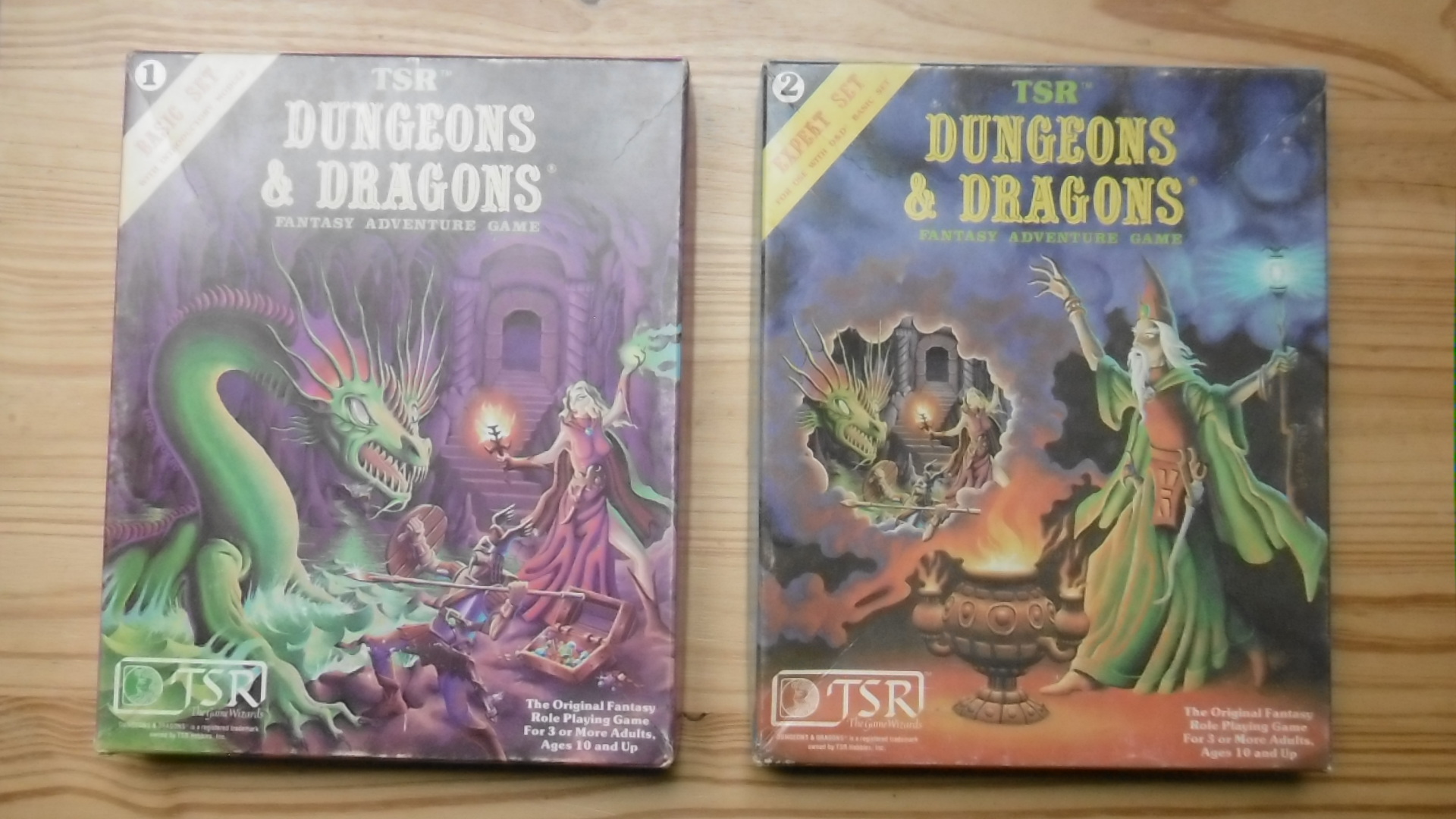Blue Flame, Tiny Stars: Now Available on DriveThruRPG
Blue Flame, Tiny Stars is now available on DriveThruRPG in paperback, EPUB, and PDF.
“Stephen’s delightful memoir makes you want to travel upstream to your own formative D&D headwaters, dig out your old graph-paper maps and worn dice, and rediscover the gateway to what the author calls ‘the fantastic path.’”
—Ethan Gilsdorf, author of Fantasy Freaks and Gaming Geeks: An Epic Quest for Reality Among Role Players, Online Gamers, and Other Dwellers of Imaginary Realms
“A vibrant recollection of what it’s like to encounter Dungeons & Dragons for the very first time.”
—Dan “Delta” Collins, author of Book of War and co-host of Wandering DMs
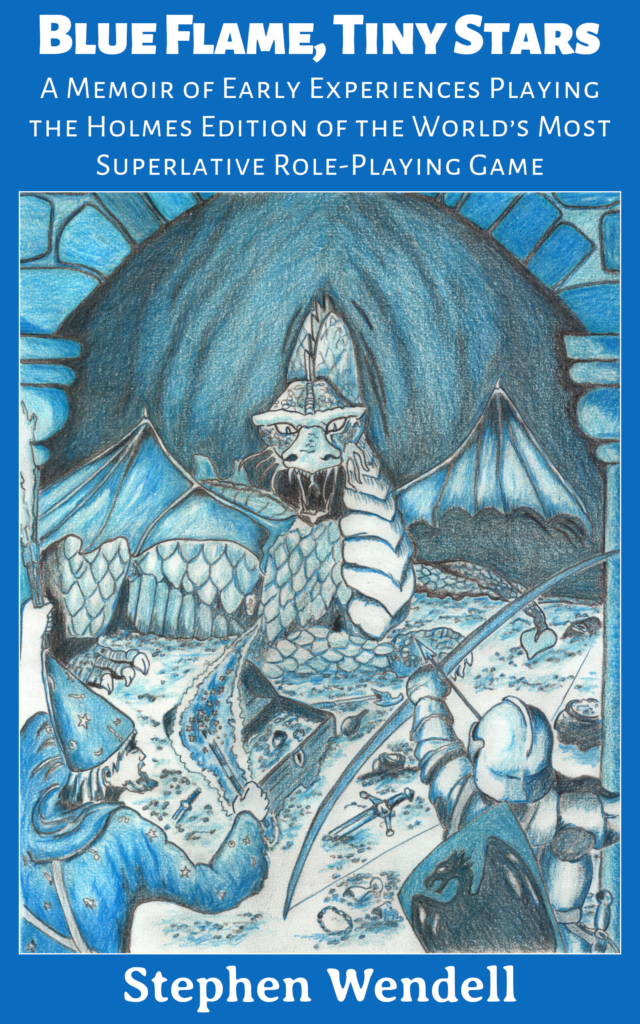
Warning: Reading this book will make you want to play D&D!

Thirteen-year-old Stephen is growing up in a mundane world until, during one fateful week in 1982, he discovers a new kind of game. It’s called Dungeons & Dragons, it’s a role-playing game, and under his best friend’s tutelage, he learns to play it. Now, he enters a world of medieval fantasy, where knights in shining armor perform heroic deeds, where monsters lurk in the shadows, and wizards wield powerful magic, where fabulous treasures lie hidden behind cunning traps, and deadly pitfalls await the unwary. In this game anything is possible, and by week’s end, Stephen knows it will change his life forever.
Praise for Blue Flame, Tiny Stars
“I recommend this book not just to fans of ‘Holmes Basic’ but to anyone who enjoys playing Dungeons & Dragons. The author’s clear prose captures the excitement of those early, half-remembered adventures when everything about the game was new and awe-inspiring.”
—Zach Howard, author of The Ruined Tower of Zenopus and archivist at Zenopus Archives
“From his first glimpse of those strange dice, Stephen paints a picture of a young gamer’s friendships and adventures as he finds his way into a new world. The book is both a wonderful narrative and a personal history.”
—Tony Dowler, author of How to Host a Dungeon: The Solo Game of Dungeon Creation
“Stephen’s essays take me right back to those heady days. You will recognise many of the moments in this book, from figuring out weird dice, employing outside-the-box tactics, inventing new spells and monsters and magic items, drawing sprawling maps—but, most of all, you’ll remember the freshness of a completely new kind of play.”
—Michael Thomas, author of BLUEHOLME
“A celebration of dice, maps, friendship, and, above all, imagination—the very stuff from which the hobby of role-playing is made.”
—James Maliszewski, author of Grognardia: Musings and Memories from a Lifetime of Roleplaying

Blue Flame, Tiny Stars—December Release
I got the second print proof last week. The color looks a lot better, outside and in. It’s a story of two friends, RGB and CMYK. One looks nice on screen, the other on paper. Perfect foils, they take turns being hero and villain.
I mentioned the too-tight margins in the first proof and thought to up the size to 5½″ × 8½″. On further reflection though, I like the smaller size for this short book. I keep the 5″ × 8″ trim size through judicious margin adjustment.
This last change made and files submitted, the book is now in process at DriveThruRPG. Blue Flame, Tiny Stars will be ready for you—barring any further complications—by mid-December.
Thank you all for your patience and for your enthusiasm. I’m looking forward to getting this book into your hands.

“I recommend this book not just to fans of ‘Holmes Basic’ but to anyone who enjoys playing Dungeons & Dragons. The author’s clear prose captures the excitement of those early, half-remembered adventures when everything about the game was new and awe-inspiring.”
—Zach Howard, author of The Ruined Tower of Zenopus and archivist at Zenopus Archives
“Stephen’s essays take me right back to those heady days. You will recognise many of the moments in this book, from figuring out weird dice, employing outside-the-box tactics, inventing new spells and monsters and magic items, drawing sprawling maps—but, most of all, you’ll remember the freshness of a completely new kind of play.”
—Michael Thomas, author of BLUEHOLME
Three Paradigms: Evolution of Ability Score Adjustments and the Prime Requisite Bonus in Old-School D&D
Because the 1981 Basic and Expert were the first D&D rulebooks I read and understood thoroughly, I see earlier editions through B/X-colored reading glasses. For examples, when in the 2000s I got my hands on the original 1974 DUNGEONS & DRAGONS rules, I understood that elves were fighter/magic-users, a magic sword +1 grants a bonus to attack and damage rolls, and ability score adjustments reduce one score to raise another.
The first thing we learn from reading the original D&D rules booklets is that one does not just read the original D&D rules booklets. It’s like casually reading a foreign language. To do so is to comprehend nothing. The OD&D rules must be studied, deciphered, and interpreted.
After struggling with the text, I figured out that, in OD&D, elves are not the fighter/magic-users I was accustomed to1, a sword +1 grants its bonus to the attack roll only2, and—most surprising—ability score adjustments do not, in fact, adjust ability scores.
Within the last example is a paradigm that shifts throughout D&D’s old-school editions.
Complimentary Paradigm
The first instance showing how to adjust the prime requisite makes the point. From the Strength entry under Determination of Abilities:
“Clerics can use strength on a 3 for 1 basis in their prime requisite area (wisdom), for purposes of gaining experience only” (Men & Magic, 10, emphasis mine).
According to the last phrase, the ability scores are not raised or lowered. We must think of the adjusted prime requisite score as a separate entry on the character sheet. If the cleric’s Strength, as rolled, is 14 and Wisdom 12, the player can use 3 points of Strength to raise Wisdom by 1. The adjusted prime requisite score is then 13. The Strength and Wisdom scores remain 14 and 12. The 3 points of Strength are used but not expended; the prime requisite is “increased” but not the Wisdom score.
To explain what’s happening in the game world, we can say that the above-average Strength compliments Wisdom and, therefore, the cleric advances faster, earning a bonus to earned experience points.
Similarly, a fighter can use 2 points of Intelligence or 3 points of Wisdom to raise the prime requisite (Strength) by 1 point. A clever fighter, like the strong cleric, advances more quickly.
If we need to be convinced, the magic-user’s case cinches it. A magic-user may use Wisdom—but not Strength—to augment earned experience. A wise magic-user may employ intellect more effectively, while Strength is of no use in the exercise of the arcane arts.
Language in the first supplement hints that players at the time were also confused about the adjustments. In Greyhawk, under the Strength entry, where the co-creator allows fighters with above-average Strength a bonus to attack and damage rolls, Gygax stipulates:
“This strength must be raw, i.e. not altered by intelligence scores” (7).
Here, we sense that Gygax knew players were ignoring “for purposes of gaining experience only” and adjusting the actual scores.
To add further confusion, Gygax goes on to allow thieves to raise the raw score.3
“[Thieves] may use 2 points of intelligence and 1 point of wisdom to increase their raw dexterity score…” (8).
Note he does not say the raw Intelligence and Wisdom scores are lowered.
The language elided above: “…so long as they do not thereby bring the intelligence and wisdom scores below average” is the same as the note given in Men & Magic (footnote, 11), where the raw scores are not changed.
As Greyhawk maintains the limited benefits of Dexterity, affecting only “the ability of characters to act/react and fire missiles” (8), thieves apply high intelligence and wisdom, not only to their experience point bonus, but also to initiative and careful aim. (As of 1976, only fighters can take advantage of high Dexterity to improve their armor class.)
Practice Paradigm
In Basic D&D (1977), editor Eric Holmes shifts from the complimentary to a practice paradigm. The editor explains in clear language:
“It is possible to raise a character’s scores in a prime requisite by lowering the scores of some of the other abilities. This recognizes that one can practice and learn feats of fighting, intelligence, etc., but must take a penalty in another area by so doing” (6).
In the practice paradigm, a magic-user can sacrifice Strength for Intelligence. Again, the lack of this option in OD&D is a tell for the complimentary paradigm.
Moldvay, with similar language, brings the practice paradigm forward into B/X, only simplifying the exchange rate, always two for one.
Complimentary vs. Practice
Apart from it just makes better sense, I prefer OD&D’s complimentary paradigm over the practice paradigm for two reasons:
- The practice paradigm, though it raises the prime requisite scores, tends to draw the two other abilities down toward 9. The 3d6 method already produces scores heavy toward the average.
- While the practice paradigm results in a net loss, the complimentary paradigm requires no sacrifice on the player’s part. No tough decision: “Do I lower strength to get one more point of wisdom…?” Therefore, character creation goes faster.
Subsumed Paradigm
Meanwhile, in the Advanced D&D Player’s Handbook (1978), Gygax omits adjustments to prime requisite scores all together. He proposes instead more generous methods to generate ability scores. The rolled scores, we infer, represent the character’s natural talent as well as any improvements and sacrifices made during one’s formative years. Furthermore, only an exceptional score (above 15) in one’s “principal attribute”—the term Gygax favors—grants a bonus to earned experience.
Brian Rogers on Mastodon points out that, according to his calculations, the chance to get an XP bonus at AD&D’s higher threshold and 4d6-drop-lowest is about the same as other old-school editions’ 13 threshold with 3d6. [13:10 02 February 2023 GMT]
But Gygax does something else in 1st Edition. He introduces ability adjustments based on race. Each player character race, except humans, receives a bonus and a penalty to two or three ability scores. For example, an elf benefits from an extra point of Dexterity, while suffering the loss of one point from Constitution. The exchange is always one for one.
Still, the adjustments represent the innate characteristics of the race. They are born in, not acquired later. Scores generated during character creation—no matter the method—represent the character’s abilities at the beginning of his or her career.
Though 3E grants ability score increases at higher levels and gives no XP bonus for high scores, and 4E grants ability score bonuses based on race without penalties, the subsumed paradigm is followed in later editions of the world’s most fascinating role-playing game.
Further Reading
- James Maliszewski sparked discussion last year about ability score adjustments and related topics on Grognardia: “What’s the Point of Ability Scores? (Part IV).” Look for the other parts as well, six total.
- If you too struggle with B/X-colored reading glasses, we are not alone. JB at B/X Blackrazor expresses his own dismay upon discovering this difference in OD&D in “Wow. I FINALLY Get It!”
- JB cites Talysman of The Nine and Thirty Kingdoms, but I don’t find the article.
- In “On prime requisites and XP adjustments” on reddit, Ivan the Unpleasant goes into some detail about each old-school edition’s treatment of prime requisites.
1 Instead of playing the familiar elf, who is at once fighter and magic-user, the OD&D player decides, before each adventure begins, which class abilities the elf will employ for the adventure (Men & Magic, 8). If we assume the game simulates a fantastic world, this makes no sense. The decision point only makes sense when we remind ourselves that D&D is a game after all.
2 See heading “Swords, Damage Bonuses” in Monsters & Treasure, 30.
3 I base the interpretation solely on the fact that Gygax employed “raw” score a few paragraphs before. I assume he would not be so sloppy with terms as to misuse this one on the next page. Or would he…? Here we might rather say, “Gygax seems to allow thieves to raise the raw score.”
Print Proof
I got the print proof this week. I note for future reference: that’s two weeks from ship date, plus four days from proof submission.
The thing in hand, I think a print edition is worth the paper and the effort necessary to get it into shape. A few corrections to be made:
The background blue is supposed to match the website header. Printed, it looks washed-out.
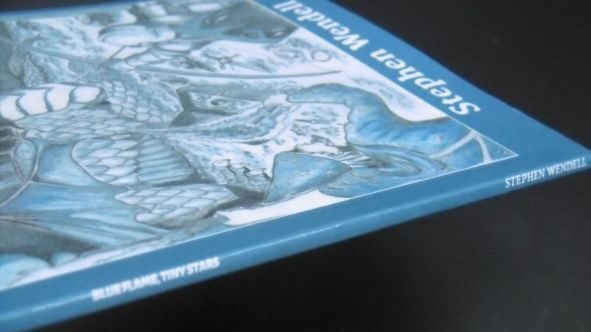
At 0.13 inches, the spine is just wide enough to allow text. I put the title, author, and publisher (not shown) in different sizes to see how they look. In printing, the cover suffered a slight rotation, which shows in the tight space—the text creeps off the spine. Including text on a narrow spine is like casting a spell through a steel sword on Tékumel: just because you can doesn’t mean you should. Spine text to be removed.
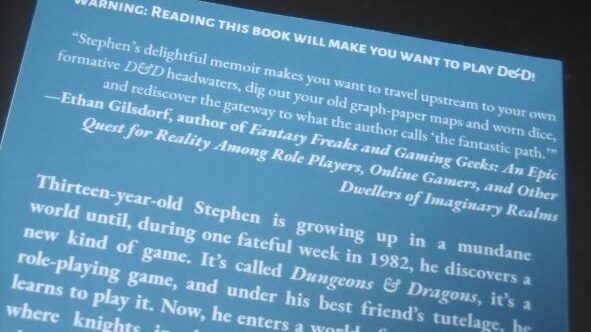
The graphic elements, which fill the allowed (printable) space, don’t breathe on the front or back covers.
At current margins, font size, and 5″ × 8″ trim, the interior text breaks at all the right places. The font size is just right, but the margins look a little tight, and the gutter (interior margin) is far too narrow. Instead of reducing the font size, I’ll add a half-inch to the trim to widen the margins. At 5½″ × 8½″, the front and back covers also breathe.
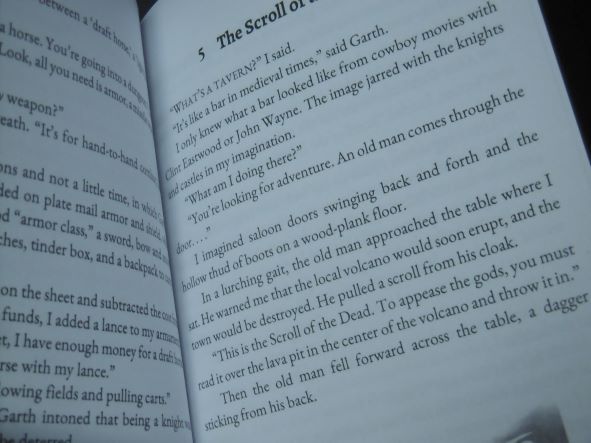
I hope those who opt for print will agree that color on the few interior images are worth an extra buck.
Another proof is necessary. That will push release date into the holiday season, a period of increased competition for reader attention and spending money. A nice-looking product is worth it.
A Craft Store Discovery
The story continues. This is the next episode following my early experiences playing Holmes Basic D&D, recounted in Blue Flame, Tiny Stars.
Memory fades like a ship on a foggy horizon when there is nothing to anchor it. So, the remainder of the summer passed into obscurity. I started high school in the fall, made new friends, and got a paper route. Of these, the last would stir the fog and give me another glimpse of D&D on the horizon.
After school, I would walk to the downtown law office where my mother worked as a legal secretary. The half-hour commute took me along the town’s main street and by the county library.
I dropped my books at the office and went to the corner convenient store, where the newspaperman left the papers, bailed in a plastic strip. I tore the strip, folded the papers, and loaded a shoulder bag made of heavy cloth, bleached white, “Citizen Tribune” printed on a side.
This wasn’t a bike-riding, paper-throwing, “’Afternoon, Mr. Wilson!” route, like we used to see on the television. It was a walking, newspaper-box route, and I never talked to or even met any of the folks who presumably read the papers I delivered.
I walked the route every day, except Mondays and Saturdays when there was no edition. My older brother drove me to the neighborhood on Sunday mornings. Every other Tuesday, I wrote the amount each subscriber owed for the period on an envelope and put it in the box with the paper. The following Friday, I collected the envelopes filled with coins and dollar bills. The route took just less than an hour. Biweekly earnings came to ten dollars and change.
One day on the after-school commute, as I turned the corner onto Main Street, something in a shop window caught my eye. A sign that stuck out over the sidewalk identified the shop as Witty’s Craft Store. The afternoon sun reflected off the glass. Shielding my eyes with a hand, I squinted through the glare.
The window was divided into two shelves. Balsa wood boxes and knitting books were arranged on the bottom shelf. On the top, above eye level, I made out a box cover and, on it, a bright green dragon. Large capital letters declared the title “DUNGEONS & DRAGONS.”
I whispered aloud, “Isn’t that the game I played with Garth…?”
The box was red violet, not the blue of the book I remembered. But it had a dragon. Facing it from the other side of the shelf, a matching box, this one blue, had a wizard. All that didn’t jive with memory, but tiny stars were flashing in my mind.
A bell dinged overhead as I pushed through the door. The store smelled like cedar and Elmer’s glue. A woman at the counter talked into a telephone.
I turned toward the window. The two boxes, each on a triangular stand, showed me their backs. I would have to reach to get them down.
The counter woman penciled notes into a ledger with one hand, while holding the receiver to her ear with the other. Glancing from the corner of an eye, she smiled and raised the pencil and an index finger at me.
I waited. A glance around the shop told me there were no other boxes with dragons or wizards on them. The shelves were filled with wooden dowels, kraft paper, and paint-by-number kits.
A moment later, the woman hung up the phone and laid the pencil on the ledger. “Hi, can I help you?”
I pointed to the blue box. “Can I look at this?”
My voice was sheepish. Shopping for me was a rare activity. Shopping on my own more so. The etiquette was unfamiliar. Here I was, asking to examine an item from the display case, as if I had money to buy it.
“Sure,” she said and went back to the ledger.
Reaching up, I took the box from its triangular stand. I was careful not to upset the stand or the other box. The contents shifted as I drew it down. Shrink-wrap crackled under my fingers.
The box in both hands, my eyes searched for a dragon atop a mound of treasure, adventurers, a magic wand. They found a wizard wearing a green robe. He gripped a staff at the end of an outstretched arm. The staff’s ornament shed a blue light. The other arm upraised, the hand empty, fingers spread, tensed, as if exerting some unseen force.
The wizard’s angular features gave him an exotic and menacing aspect. He had bony joints and a triangle nose. The robe bent at angles rather than flowing in smooth curves. I found a wand hanging from his belt, secured by two loops. The loops were rigid and angular, as if made from metal. The wooden staff crooked at right angles.
From beneath a pointed cap flowed stark white hair. Also white, a beard framed a small mouth, open in a gasp, and bushy brows raised over wide eyes. The pupils focused on a scene in a cloud of smoke that billowed from a flaming brazier. The scene contained two adventurers confronting a dragon. Still no treasure.
“That’s the second one,” said the woman. “You have to start with the other one.”
A black number “2” in a white circle was printed in the upper left corner above a yellow banner that read “EXPERT SET for use with D&D Basic Set.” In the left corner, a sticker put the price at $10.00.
“Okay.” I nodded, looking up from the box. “Do you know anything about this game?”
Her thick, blond hair was tied back. It had a gray tinge that matched her complexion. “No, I’m sorry. Not really.”
I ran my fingers along the box edge, feeling the shrink-wrap’s seams. “Can I see what’s inside?”
“There’s a picture on the back.”
I turned the box over. A black-and-white photograph showed the box in miniature beside two books. One book shared the image from the box top. Neither looked like the pale blue book Garth had. Also in the photo, I made out a crayon and multi-sided dice.
Garth’s voice sounded in my head: “They’re polyhedrons.”
Above the photo, a block of text in a red rectangle warned that I could not play this game by itself. I needed the basic rulebook.
I replaced the blue box in its stand and took the violet. Other than the crackling shrink-wrap and shifting box contents, the store was quiet. Every sound I made was amplified in my ears. I felt the woman’s gaze.
I looked first at the back. No warning on this one. Below a similar photograph showing the contents, I scanned small text that described a scene: a sword, a fight with a dragon, treasure. I stopped on a line:
“‘What do you want to do now?’ asks the Dungeon Master.”
Garth was always asking Jarrod and I what we wanted to do. And didn’t he call himself the dungeon master?
I turned to the front. The dragon’s green skin stood out against violet cavern walls. Two figures, with the same angled features as the wizard, attacked it. One, an armored man with a spear, the other, a woman with a green flaming ball. The man defended himself with a wooden shield and wore armor and a winged helm. The woman held a torch. She wore a sleeveless robe, one leg exposed from thigh to calf boot. A dagger hung from a waist belt. At her feet, an open chest spilled coins and sparkling gems— treasure!
The number in the upper left was a “1.” The banner text read, “BASIC SET with Introductory Module.” Like the other set, the price was $10.00. In the lower right corner, I read: “The Original Fantasy Role Playing Game For 3 or More Adults, Ages 10 and Up.”
This must be the game. It was Tuesday. Envelopes would go in paper boxes today. I returned the box to its stand and thanked the woman for her time. The bell dinged as I went through the door. I could not bare to look again at the boxes in the shop window as I strode by, head bent, full of anticipation.
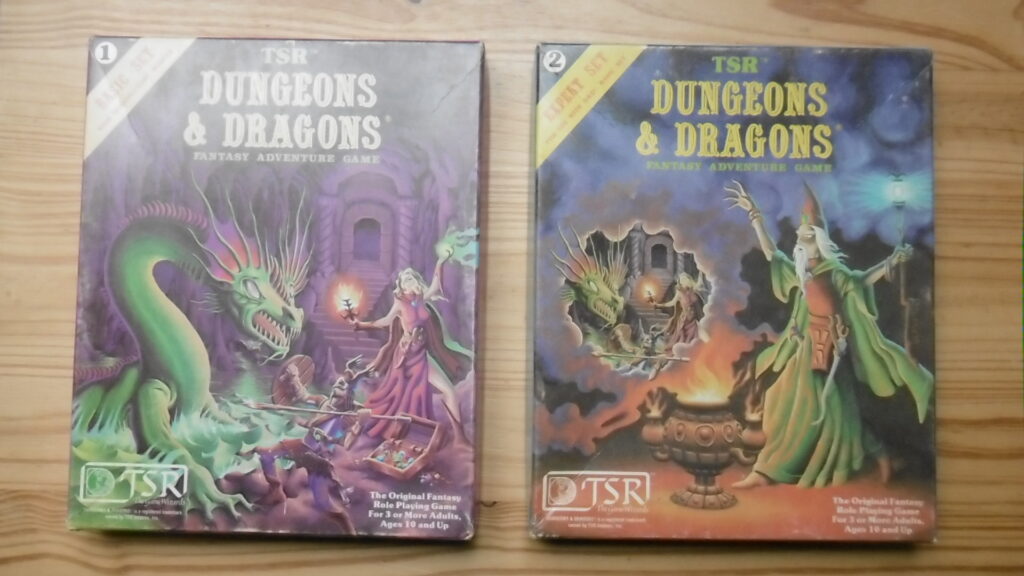
Edited by Tom Moldvay and David Cook with Steve Marsh (Lake Geneva, WI: TSR Hobbies, 1981), this edition, known as B/X D&D, and its retro-clones today enjoy a large and growing fan base.
Where is Blue Flame, Tiny Stars?
I should have a print proof any day now. For more info, please see “Considering a Print Edition.”
To get the latest news, follow me on Twitter or Facebook or subscribe to new articles on DONJON LANDS (sidebar).
Considering a Print Edition
The release of Blue Flame, Tiny Stars is back on. The bad news is a publishing deal for a print edition didn’t work out. The good news is I am thinking to do it myself.
The book is short—about 30 reading pages, hence my reluctance. With front and back matter, it comes to 45 total. The printer requires a book of that size to have a page count divisible by six. That makes a thin volume, but I can think of another book that has only 48 pages.
Formatting the manuscript for print requires some labor, the cover quite some more, and receiving print proofs requires time. The labor is done. A proof copy is on the way, scheduled to arrive mid-October. I’ll have a look at it and decide if it’s worth the pulp.
Expect an update in about two weeks. Thank you for your patience and your support.

Release Suspended
The release of Blue Flame, Tiny Stars is temporarily suspended. It’s too early to say why I’ve done so, but—potentially—it is good news for the book. I will give more details here as soon as I am able. Thank you for your patience.

Imminent Release
My latest book is due for release anytime now. This one, though short, is close to my heart. If inspiration for everything I have written—and everything I will write—comes from a source, this book is about the source.
Could be a day, could be a week. I have done the necessary on the vendor website. As DONJON LANDS is a new publisher with the vendor, the product page is subject to human review. In any event, Blue Flame, Tiny Stars will be available soon on DriveThruRPG.
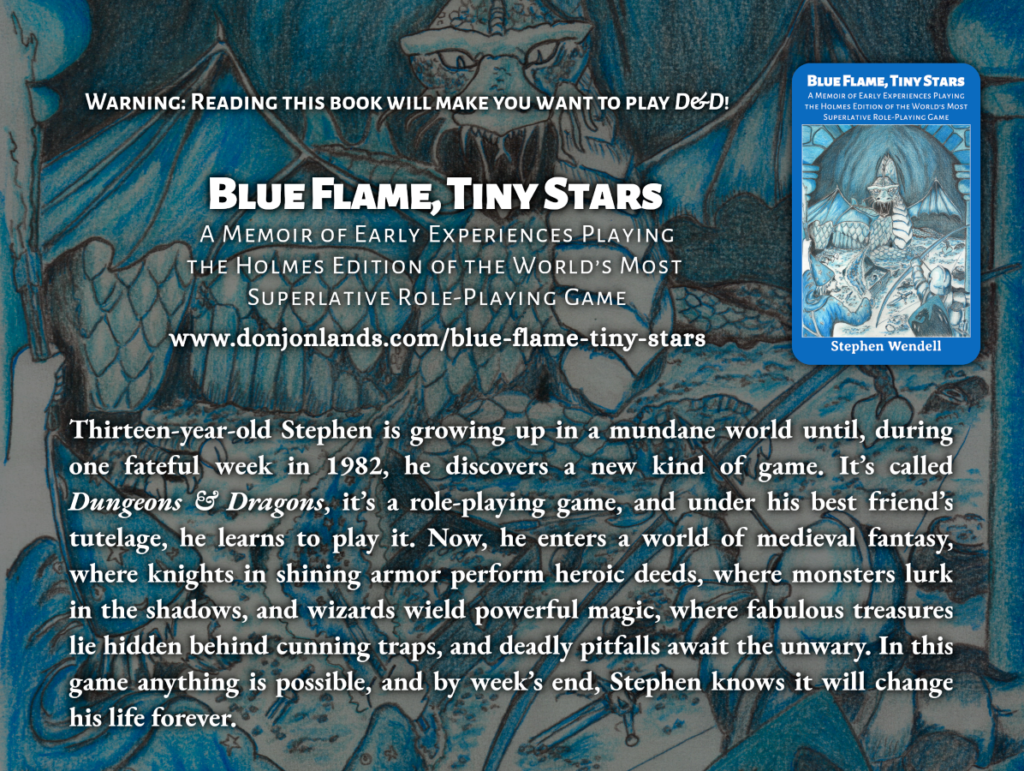
Coming in September: Blue Flame, Tiny Stars

“Stephen’s delightful memoir makes you want to travel upstream to your own formative D&D headwaters, dig out your old graph-paper maps and worn dice, and rediscover the gateway to what the author calls ‘the fantastic path.’”
—Ethan Gilsdorf, author of Fantasy Freaks and Gaming Geeks: An Epic Quest for Reality Among Role Players, Online Gamers, and Other Dwellers of Imaginary Realms
“A celebration of dice, maps, friendship, and, above all, imagination—the very stuff from which the hobby of role-playing is made.”
—James Maliszewski, author of Grognardia: Musings and Memories from a Lifetime of Roleplaying
